An Effective Force-Temperature-Humidity Coupled Modeling for PEMFC Performance Parameter Matching by Using CFD and FEA Co-Simulation
Abstract
:1. Introduction
1.1. The Need for the Performance Parameter Matching in Fuel Cells
1.2. Review of the Performance Parameters Studies for PRMFCs
2. Model Description of Force-Temperature-Humidity Coupled Model
2.1. Force-Temperature and Temperature-Humidity Coupled Model
2.2. Force-Temperature-Humidity Multi-Field Coupled PEMFC Model
3. Results and Discussions
3.1. Effects of Operating Temperature on the Performance Parameters
3.2. Effects of Hydrogen/Air Stoichiometric Ratio on the Performance Parameters
3.3. Effects of the Relative Humidity Distribution on the Performance Parameters
4. Conclusions
Author Contributions
Funding
Institutional Review Board Statement
Informed Consent Statement
Data Availability Statement
Conflicts of Interest
References
- Jiao, K.; Xuan, J.; Du, Q.; Guiver, M.D. Designing the next generation of proton-exchange membrane fuel cells. Nature 2021, 595, 361–369. [Google Scholar] [CrossRef] [PubMed]
- Zeng, T.; Zhang, C.; Hao, D.; Cao, D.; Chen, J.; Chen, J.; Li, J. Data-driven approach for short-term power demand prediction of fuel cell hybrid vehicles. Energy 2020, 208, 118319. [Google Scholar] [CrossRef]
- Dong, P.; Zhao, J.; Liu, X.; Wu, J.; Xu, X.; Liu, Y.; Wang, S.; Guo, W. Practical application of energy management strategy for hybrid electric vehicles based on intelligent and connected technologies: Development stages, challenges, and future trends. Renew. Sustain. Energy Rev. 2022, 170, 112947. [Google Scholar] [CrossRef]
- Zhou, J.; Feng, C.; Su, Q.; Jiang, S.; Fan, Z.; Ruan, J.; Sun, S.; Hu, L. The Multi-Objective Optimization of Powertrain Design and Energy Management Strategy for Fuel Cell–Battery Electric Vehicle. Sustainability 2022, 14, 6320. [Google Scholar] [CrossRef]
- Xu, X.; Zhao, J.; Zhao, J.; Shi, K.; Dong, P.; Wang, S.; Liu, Y.; Guo, W.; Liu, X. Comparative study on fuel saving potential of series-parallel hybrid transmission and series hybrid transmission. Energy Convers. Manag. 2022, 252, 114970. [Google Scholar] [CrossRef]
- Zhang, Z.; Wu, S.; Miao, H.M.; Zhang, T. Numerical Investigation of Flow Channel Design and Tapered Slope Effects on PEM Fuel Cell Performance. Sustainability 2022, 14, 11167. [Google Scholar]
- Zeng, T.; Zhang, C.; Zhang, Y.; Deng, C.; Hao, D.; Zhu, Z.; Ran, H.; Cao, D. Optimization-oriented adaptive equivalent consumption minimization strategy based on short-term demand power prediction for fuel cell hybrid vehicle. Energy 2021, 227, 120305. [Google Scholar] [CrossRef]
- Zhang, Y.; Zhang, C.; Huang, Z.; Xu, L.; Liu, Z.; Liu, M. Real-Time Energy Management Strategy for Fuel Cell Range Extender Vehicles Based on Nonlinear Control. IEEE Trans. Transp. Electrif. 2019, 5, 1294–1305. [Google Scholar] [CrossRef]
- Zhang, C.; Cao, X.; Bujlo, P.; Chen, B.; Zhang, X.; Sheng, X.; Liang, C. Review on the safety analysis and protection strategies of fast filling hydrogen storage system for fuel cell vehicle application. J. Energy Storage 2022, 45, 103451. [Google Scholar] [CrossRef]
- Niu, T.; Huang, W.; Zhang, C.; Zeng, T.; Chen, J.; Li, Y.; Liu, Y. Study of degradation of fuel cell stack based on the collected high-dimensional data and clustering algorithms calculations. Energy AI 2022, 10, 100184. [Google Scholar] [CrossRef]
- Ji, X.; Wang, X.; Li, Y.; Guo, J.; Yang, Z.; Hao, D. Sensitivity analysis of operating parameters on a 65 kW proton exchange membrane fuel cell stack performances. Energy Rep. 2022, 8, 521–527. [Google Scholar] [CrossRef]
- Sun, W.; Yi, F.; Hu, D.; Zhou, J. Research on matching design method of waste heat reuse system of fuel cell vehicle considering system energy consumption and waste heat exchange rate. Int. J. Energy Res. 2021, 45, 5470–5485. [Google Scholar] [CrossRef]
- Yang, Y.; Jia, H.; Liu, Z.; Bai, N.; Zhang, X.; Cao, T.; Zhang, J.; Zhao, P.; He, X. Overall and local effects of operating parameters on water management and performance of open-cathode PEM fuel cells. Appl. Energy 2022, 315, 118978. [Google Scholar] [CrossRef]
- Zhang, B.; Lin, F.; Zhang, C.; Liao, R.; Wang, Y. Design and implementation of model predictive control for an open-cathode fuel cell thermal management system. Renew. Energy 2020, 154, 1014–1024. [Google Scholar] [CrossRef]
- Zhang, Z.; Zhang, J.; Zhang, T. A Study of Contact Pressure with Thermo-Mechanical Coupled Action for a Full-Dimensional PEMFC Stack. Sustainability 2022, 14, 8593–8610. [Google Scholar] [CrossRef]
- Zhang, Z.; Zhang, J.; Zhang, T. Endplate Design and Topology Optimization of Fuel Cell Stack Clamped with Bolts. Sustainability 2022, 14, 4730–4743. [Google Scholar] [CrossRef]
- Huang, J.; Xiao, H.; Hu, J.; Mu, R.; Chen, Z. The influence of baffle geometry on mass transfer and performance of proton exchange membrane fuel cells considering the compression of gas diffusion layer. Int. J. Hydrogen Energy 2022, 47, 21403–21416. [Google Scholar] [CrossRef]
- Molaeimanesh, G.R.; Nazemian, M. Investigation of GDL compression effects on the performance of a PEM fuel cell cathode by lattice Boltzmann method. J. Power Sources 2017, 359, 494. [Google Scholar] [CrossRef]
- Xing, L.; Wang, Y.; Prodip, K.; Das Keith, S.; Shi, W. Homogenization of current density of PEM fuel cells by in-plane graded distributions of platinum loading and GDL porosity. Chem. Eng. Sci. 2018, 192, 699. [Google Scholar] [CrossRef] [Green Version]
- Hu, D.; Wang, Y.; Li, J.; Yang, Q.; Wang, J. Investigation of optimal operating temperature for the PEMFC and its tracking control for energy saving in vehicle applications. Energy Convers. Manag. 2021, 249, 114842. [Google Scholar] [CrossRef]
- Dong, Z.; Liu, Y.; Qin, Y. Coupled FEM and CFD Modeling of Structure Deformation and Performance of PEMFC Considering the Effects of Membrane Water Content. Energies 2022, 15, 5319. [Google Scholar] [CrossRef]
- Qiu, D.; Peng, L.; Yi, P.; Lehnert, W.; Lai, X. Review on proton exchange membrane fuel cell stack assembly: Quality evaluation, assembly method, contact behavior and process design. Renew. Sustain. Energy Rev. 2021, 152, 111660. [Google Scholar] [CrossRef]
- Wu, C.W.; Zhang, W.; Han, X.; Zhang, Y.X.; Ma, G.J. A systematic review for structure optimization and clamping load design of large proton exchange membrane fuel cell stack. Power Sources 2020, 476, 228724. [Google Scholar] [CrossRef]
- Yan, X.; Lin, C.; Zheng, Z.; Chen, J.; Wei, G.; Zhang, J. Effect of assembly force on liquid-cooled PEMFC stack performance considering inhomogeneous gas diffusion layer compression. Appl. Energy 2020, 258, 114073. [Google Scholar] [CrossRef]
- Ouaidat, G.; Cherouat, A.; Kouta, R.; Chamoret, D. Study of the effect of mechanical uncertainties parameters on performance of PEMFC by coupling a 3D numerical multiphysics model and design of experiment. Int. J. Hydrogen Energy 2022, 47, 23772–23786. [Google Scholar] [CrossRef]
- Yin, C.; Cao, J.; Tang, Q.; Su, Y.; Wang, R.; Li, K.; Tang, H. Study of internal performance of commercial-size fuel cell stack with 3D multi-physical model and high resolution current mapping. Appl. Energy 2022, 323, 119567. [Google Scholar] [CrossRef]
- Bai, F.; Quan, H.; Yin, R.-J.; Zhang, Z.; Jin, S.-Q.; He, P.; Mu, Y.-T.; Gong, X.-M.; Tao, W.-Q. Three-dimensional multi-field digital twin technology for proton exchange membrane fuel cells. Appl. Energy 2022, 324, 119763. [Google Scholar] [CrossRef]
- Fu, X.; Wen, Q.; Han, J.; Wei, J.; Li, Y.; Ning, F.; Zhou, X. One-step to prepare high-performance gas diffusion layer (GDL) with three different functional layers for proton exchange membrane fuel cells (PEMFCs). Int. J. Hydrogen Energy 2022, 47, 25769–25779. [Google Scholar] [CrossRef]
- Prince Abraham, B.; Kalidasa Murugavel, K. Influence of Catalyst Layer and Gas Diffusion Layer Porosity in Proton Exchange Membrane Fuel Cell Performance. Electrochim. Acta 2021, 389, 138793. [Google Scholar]
- Son, J.; Um, S.; Kim, Y.-B. Numerical analysis of the effect of anisotropic gas diffusion layer permeability on polymer electrolyte membrane fuel cell performance with various channel types. Fuel 2021, 289, 119888. [Google Scholar] [CrossRef]
- Toghyani, S.; Moradi Nafchi, F.; Afshari, E.; Hasanpour, K.; Baniasadi, E.; Atyabi, S.A. Thermal and electrochemical performance analysis of a proton exchange membrane fuel cell under assembly force on gas diffusion layer. Int. J. Hydrogen Energy 2018, 43, 4534–4545. [Google Scholar] [CrossRef]
- Shi, L.; Xu, S.; Liu, J. Influences of assembly force and flow channel size on performances of proton exchange membrane fuel cells based on a multi-model. Int. J. Hydrogen Energy 2022, 47, 7902–7914. [Google Scholar] [CrossRef]
- Kerkoub, Y.; Benzaoui, A.; Haddad, F.; Ziari, Y.K. Channel to rib width ratio influence with various flow field designs on performance of PEM fuel cell. Energy Convers. Manag. 2018, 174, 260–275. [Google Scholar] [CrossRef]
- Carcadea, E.; Ismail, M.S.; Bin Ingham, D.; Patularu, L.; Schitea, D.; Marinoiu, A.; Ion-Ebrasu, D.; Mocanu, D.; Varlam, M. Effects of geometrical dimensions of flow channels of a large-active-area PEM fuel cell: A CFD study. Int. J. Hydrogen Energy 2021, 46, 13572–13582. [Google Scholar] [CrossRef]
- Azarafza, A.; Ismail, M.S.; Rezakazemi, M.; Pourkashanian, M. Comparative study of conventional and unconventional designs of cathode flow fields in PEM fuel cell. Renew. Sustain. Energy Rev. 2019, 116, 350–366. [Google Scholar] [CrossRef]
- Zhou, P.; Wu, C.W.; Ma, G.J. Contact resistance prediction and structure optimization of bipolar plates. J. Power Sources 2006, 159, 1115–1122. [Google Scholar] [CrossRef]

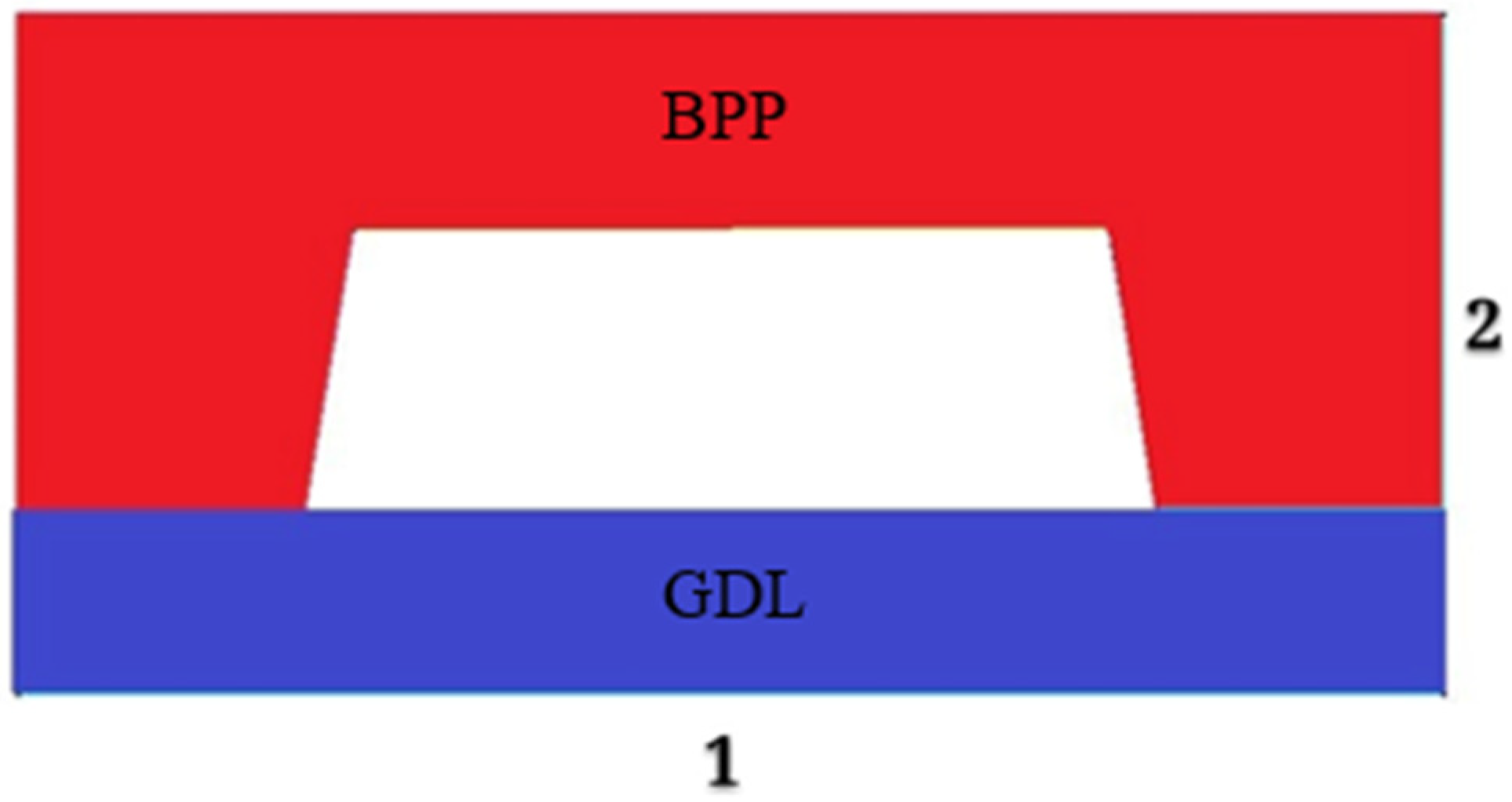
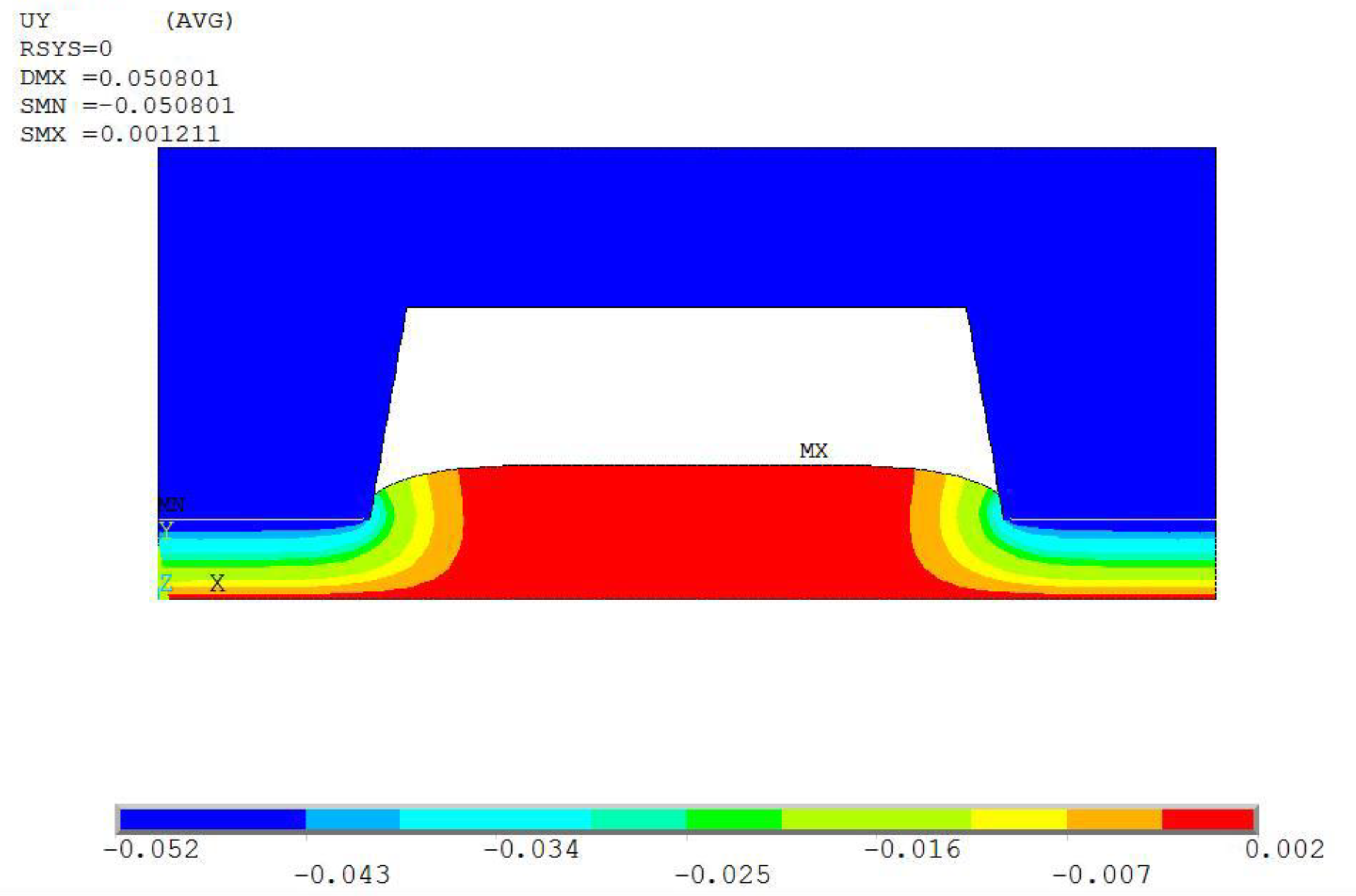
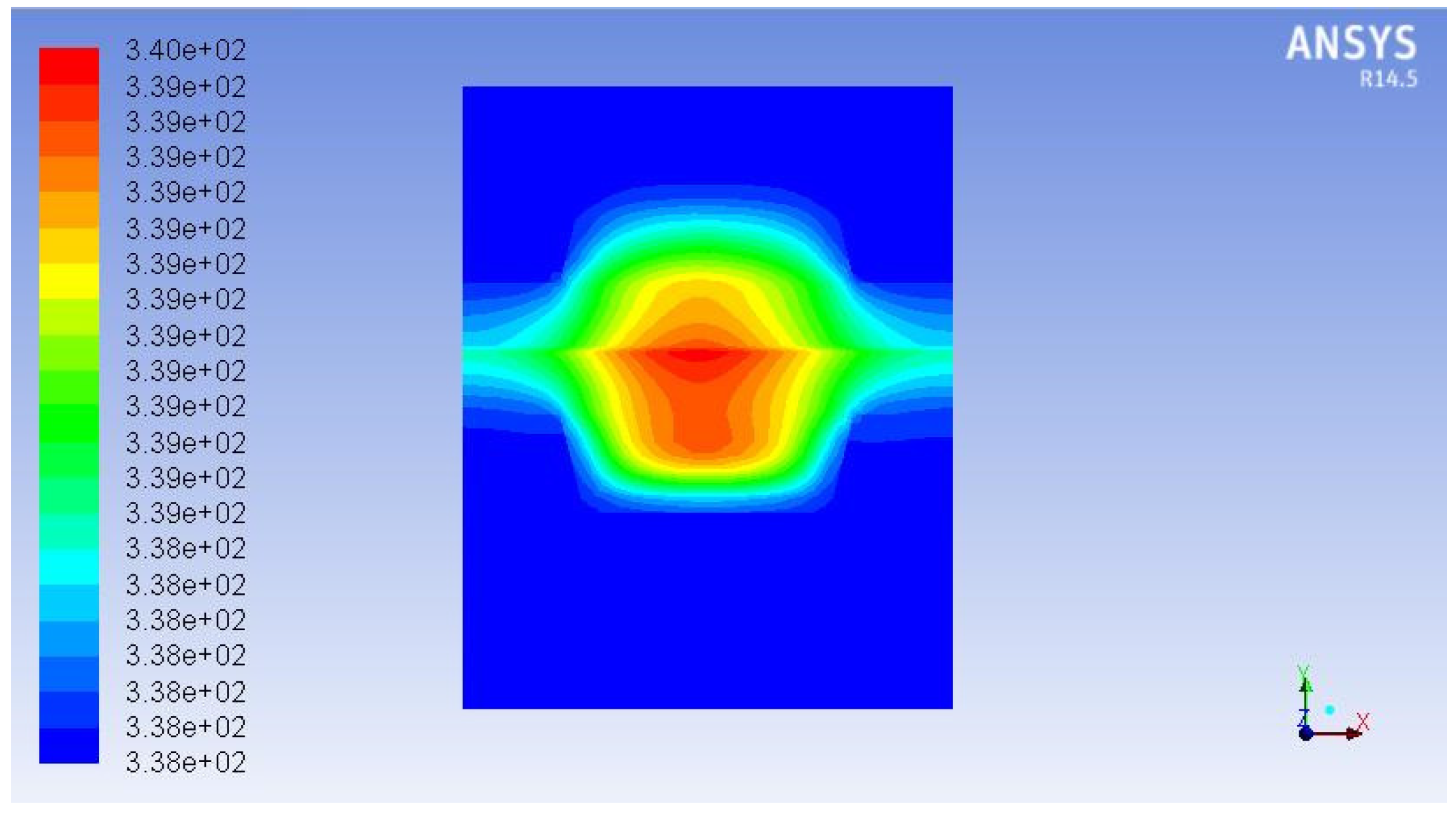

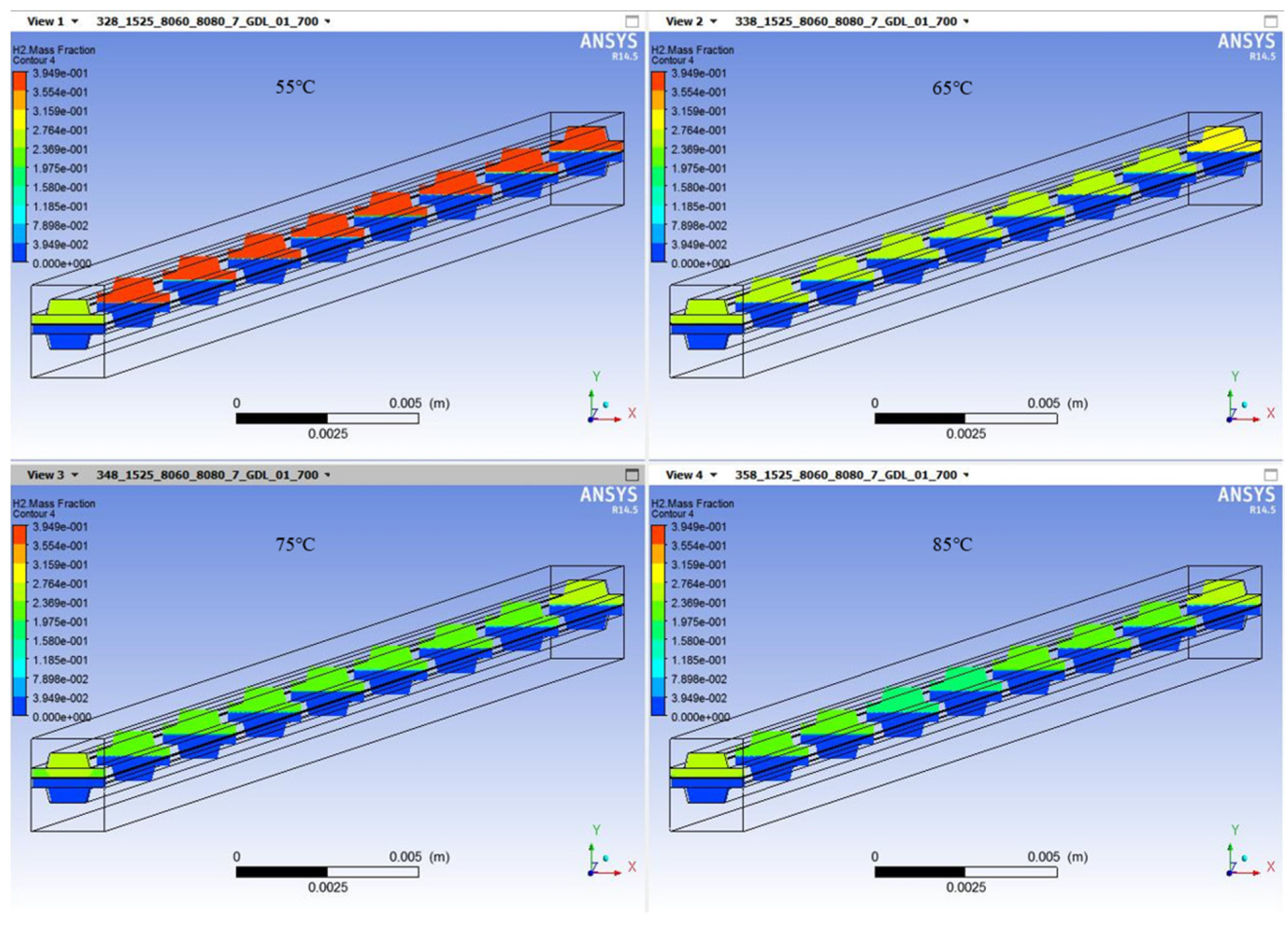
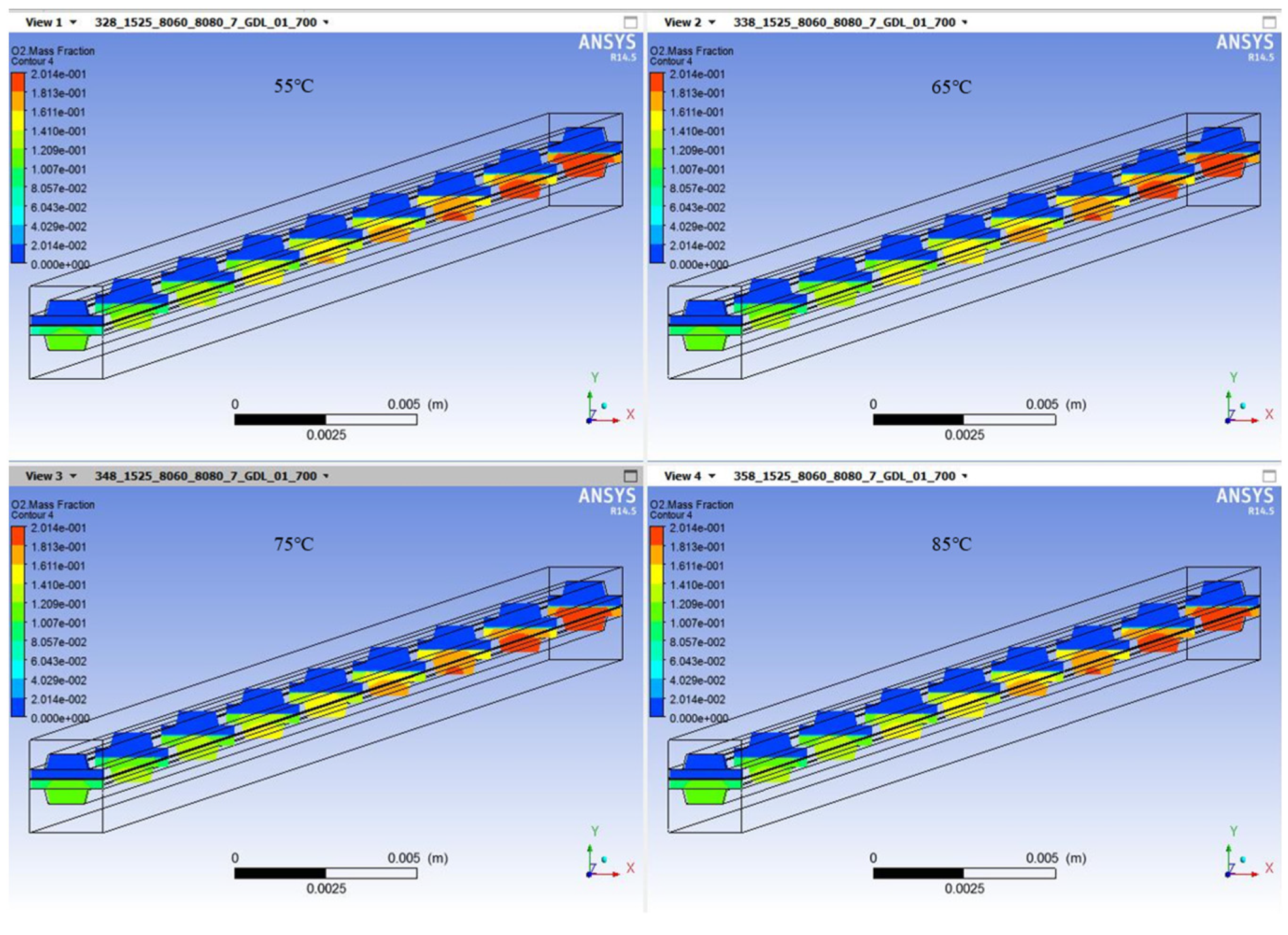

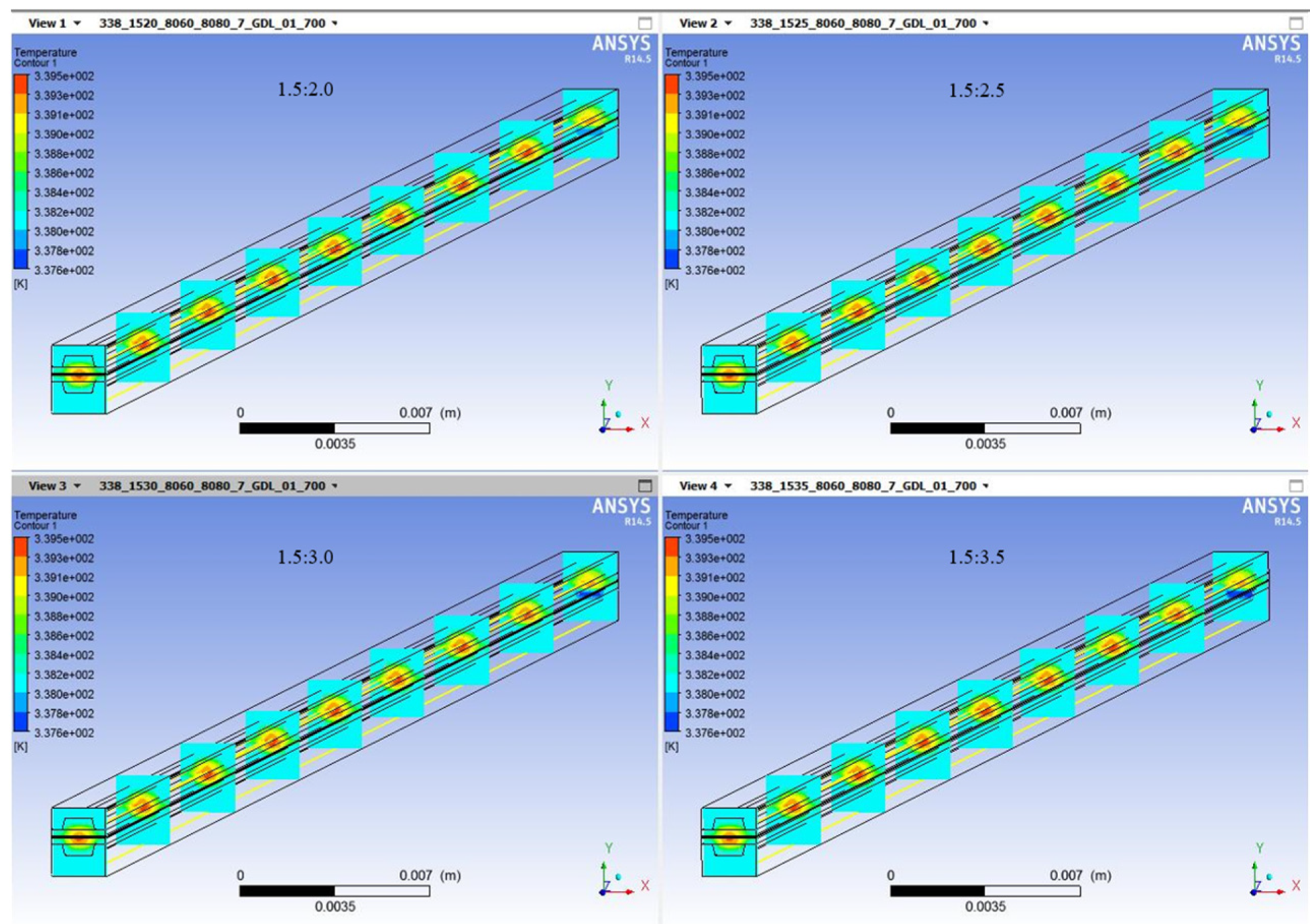



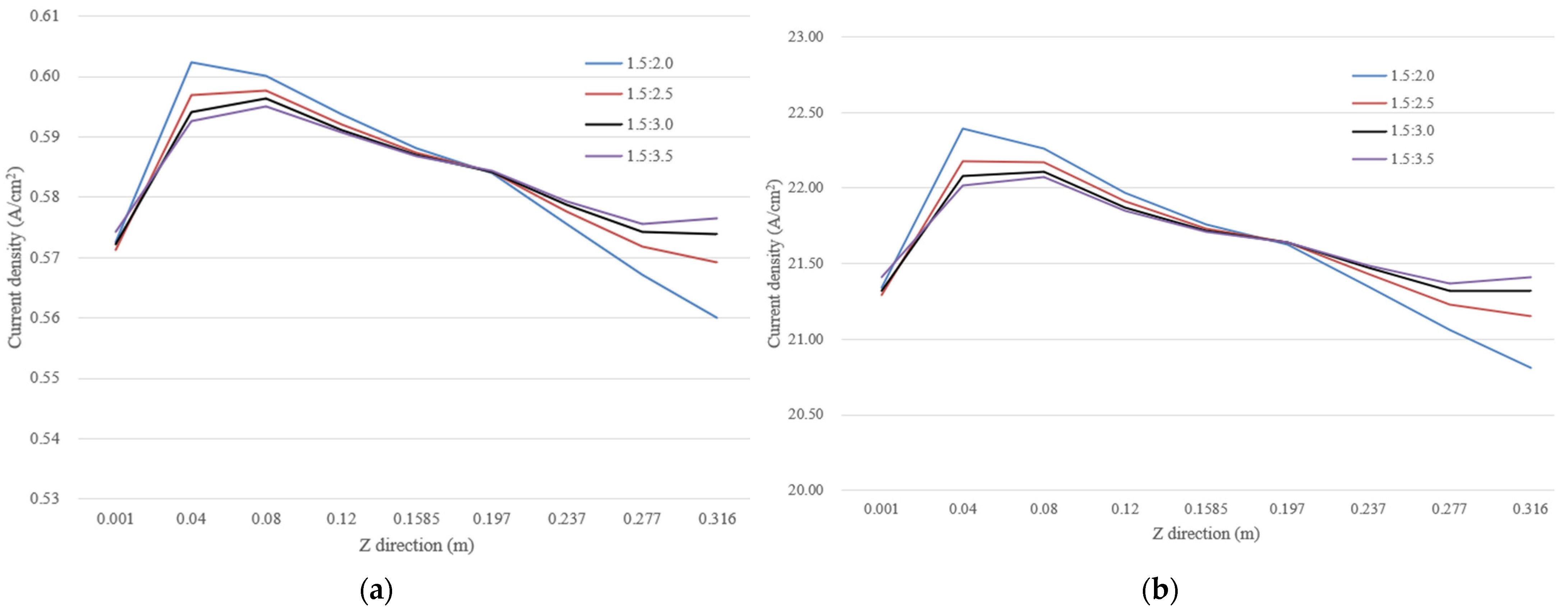

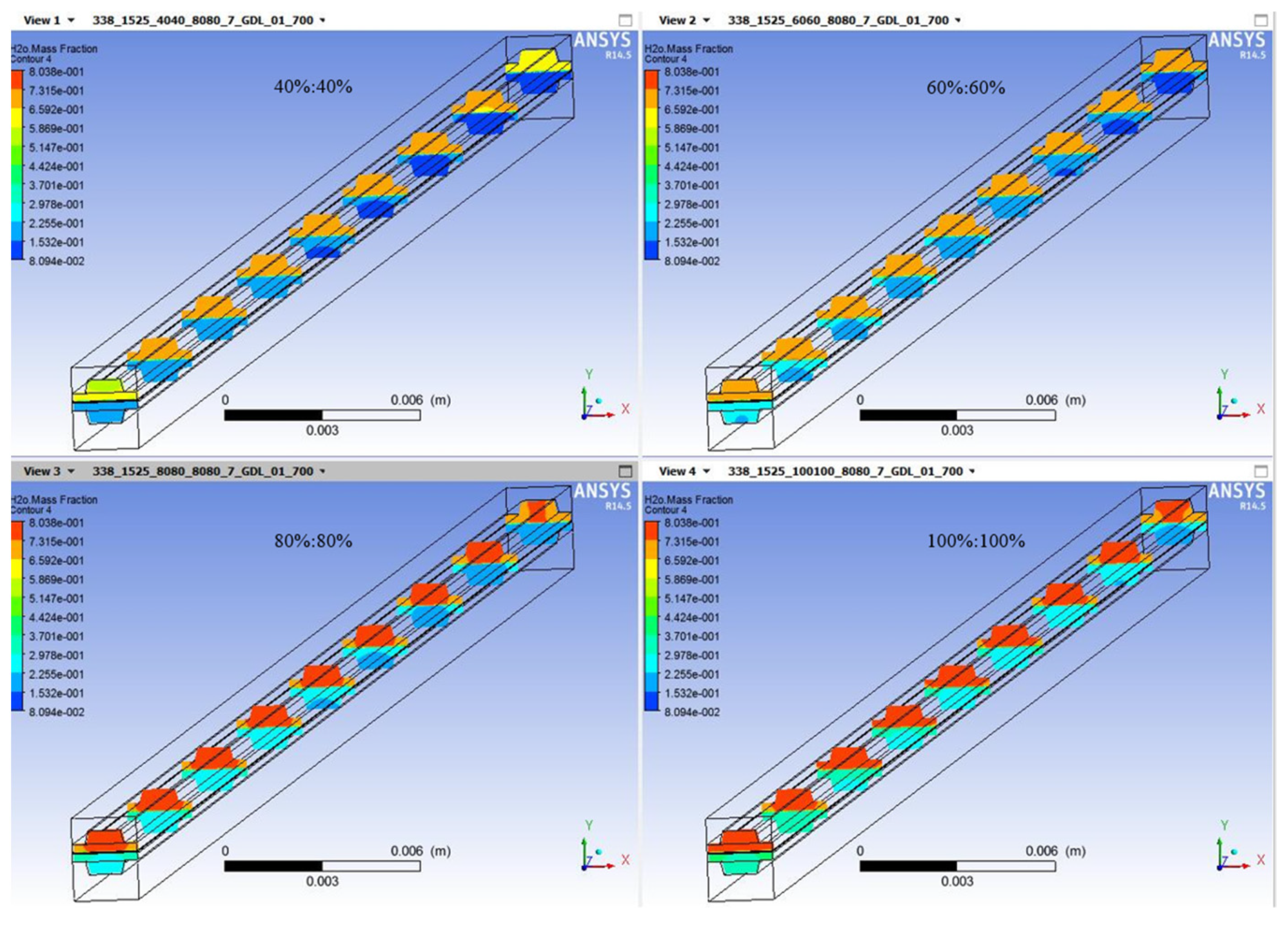
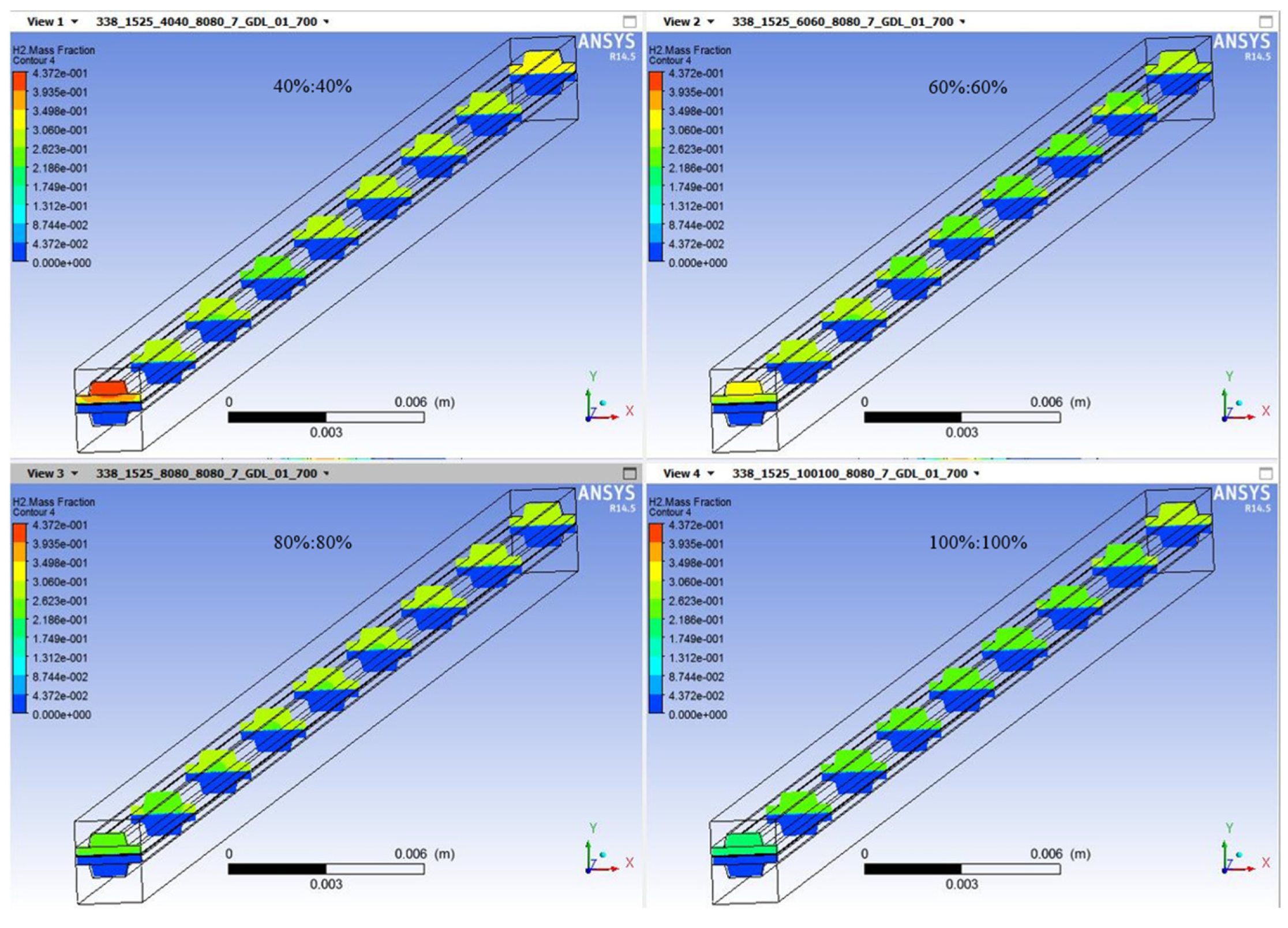

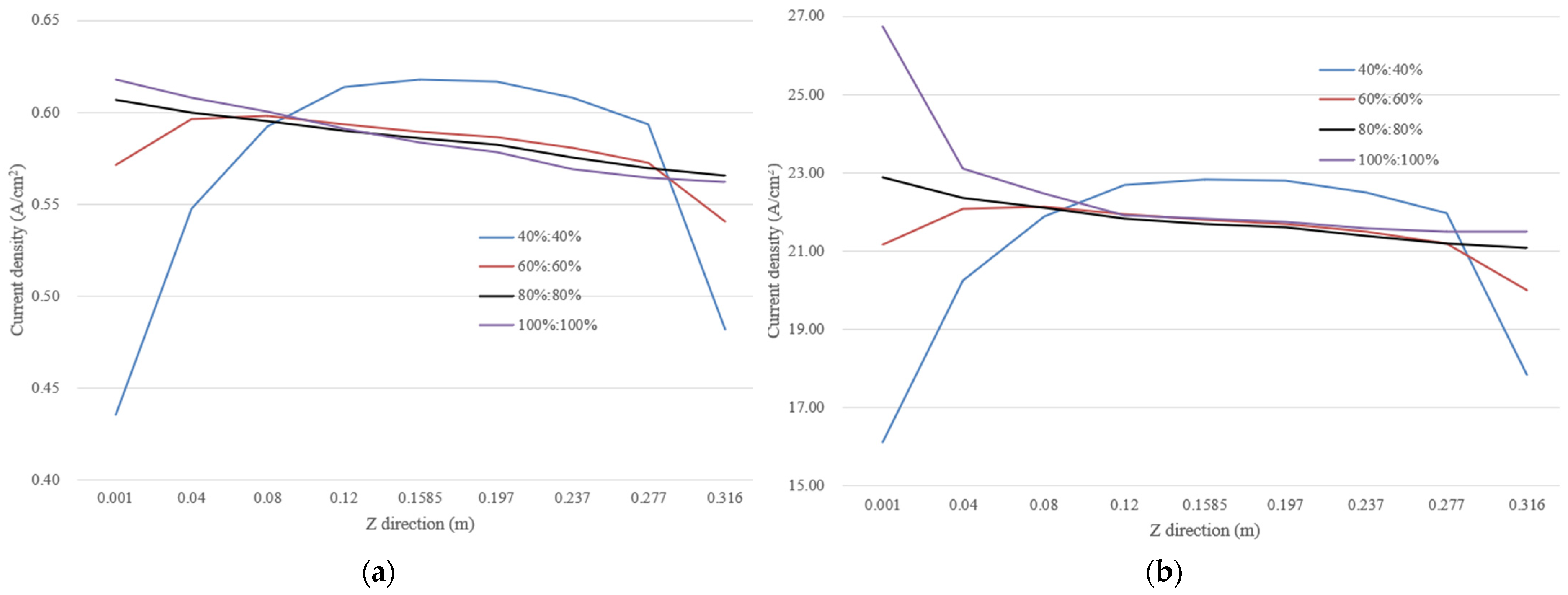
| Component | Height/mm | Width/mm | Length/mm |
|---|---|---|---|
| Anode BPP | 0.8 | 2 | 317 |
| Cathode BPP | 1.2 | 2 | 317 |
| Flow Channel | 0.4 | 1.2 | 317 |
| GDL | 0.25 | 2 | 317 |
| CL | 0.008 | 2 | 317 |
| PEM | 0.025 | 2 | 317 |
| Material Properties | Value | Units |
|---|---|---|
| coefficient of linear expansion | 1.7 a | 10−6·K−1 |
| 22 b | ||
| thermal conductivity | 15 a | W·m−1 K−1 |
| −0.8 b | ||
| elastic modulus | 6.13 | MPa |
| Poisson’s ratio | 0.09 | |
| specific heat capacity | 711.76 | J·kg−1·K−1 |
| density | 450 | Kg·m−3 |
| Equation | Description * |
|---|---|
| mass conservation equation [33] | |
| momentum conservation equation [33] | |
| energy conservation equation [33] | |
| the Butler–Volmer equation [34] | |
| current conservation equation [34] | |
| diffusion equation in the porous zone [35] |
| Parameters | Units | Description |
|---|---|---|
| porosity | ||
| kg∙m−3 | gas density | |
| m∙s−1 | gas velocity | |
| kmol∙m−3 | mass source term | |
| kg∙kmol−1 | molar mass | |
| C∙mol−1 | Faraday constant | |
| A∙m−3 | volumetric current density | |
| Pa | pressure | |
| kg∙m−2∙s−1 | momentum source term | |
| μ | Pa∙s | viscosity |
| J∙kg−1K−1 | specific heat at constant pressure | |
| K | temperature | |
| W∙m−1∙K−1 | effective thermal conductivity | |
| W∙m−3 | energy source term | |
| η | V | overpotential |
| A∙m−2 | reference exchange current density | |
| kmol∙m−3 | molar concentration | |
| kmol∙m−3 | reference molar concentration | |
| concentration index | ||
| charge transfer coefficient | ||
| σ | s∙m−1 | charge or electron conductivity |
| ϕ | V | phase potential |
| A∙m−3 | current source term | |
| liquid water saturation | ||
| liquid water saturation index | ||
| m2∙s−1 | diffusion coefficient | |
| m2∙s−1 | diffusion coefficient at and | |
| pressure index | ||
| K | reference temperature | |
| Pa | reference pressure | |
| к | m−2 | viscous resistance in porous zone |
Publisher’s Note: MDPI stays neutral with regard to jurisdictional claims in published maps and institutional affiliations. |
© 2022 by the authors. Licensee MDPI, Basel, Switzerland. This article is an open access article distributed under the terms and conditions of the Creative Commons Attribution (CC BY) license (https://creativecommons.org/licenses/by/4.0/).
Share and Cite
Zhang, Z.; Wu, S.; Li, K.; Zhou, J.; Zhang, C.; Wang, G.; Zhang, T. An Effective Force-Temperature-Humidity Coupled Modeling for PEMFC Performance Parameter Matching by Using CFD and FEA Co-Simulation. Sustainability 2022, 14, 14416. https://doi.org/10.3390/su142114416
Zhang Z, Wu S, Li K, Zhou J, Zhang C, Wang G, Zhang T. An Effective Force-Temperature-Humidity Coupled Modeling for PEMFC Performance Parameter Matching by Using CFD and FEA Co-Simulation. Sustainability. 2022; 14(21):14416. https://doi.org/10.3390/su142114416
Chicago/Turabian StyleZhang, Zhiming, Sai Wu, Kunpeng Li, Jiaming Zhou, Caizhi Zhang, Guofeng Wang, and Tong Zhang. 2022. "An Effective Force-Temperature-Humidity Coupled Modeling for PEMFC Performance Parameter Matching by Using CFD and FEA Co-Simulation" Sustainability 14, no. 21: 14416. https://doi.org/10.3390/su142114416






